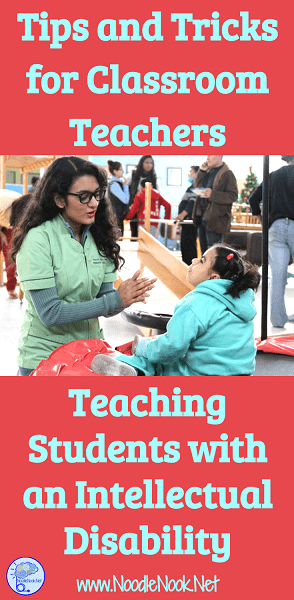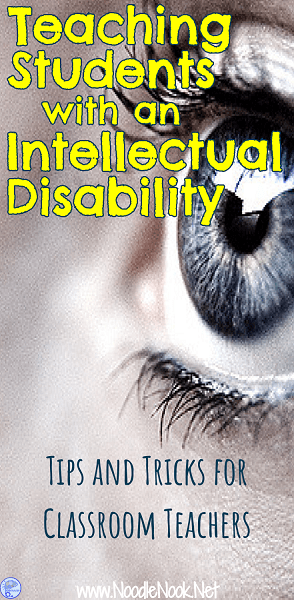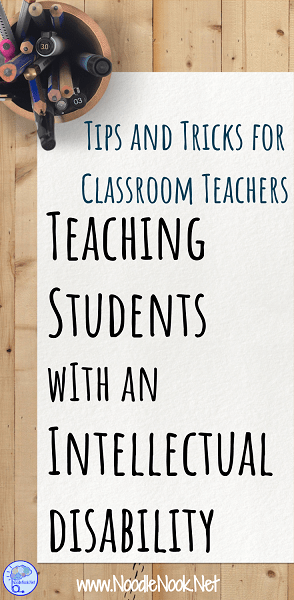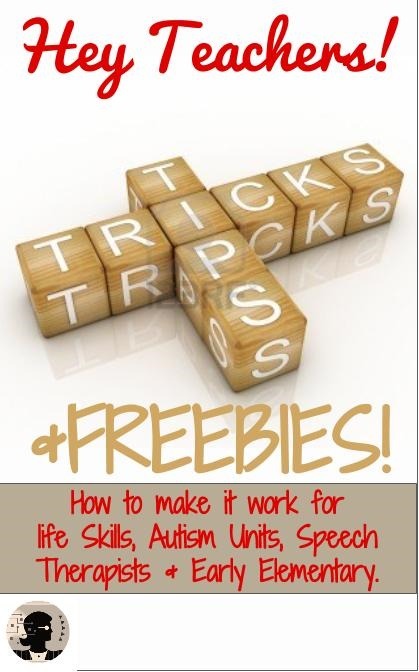Teaching Students with an Intellectual Disability
If you teach in a mixed ability self contained classroom, you will have at least one or two students who have an intellectual disability. When it comes to setting up your classroom and lessons to give them the best education, here are some strategies for teaching students with an intellectual disability.
Characteristics of An Intellectual Disability
In the most simplest terms, a student with an Intellectual Disability (ID) has difficulty thinking and understanding. Because of those difficulties, they may be challenged when learning new things, generalizing skills, independently completing functional tasks, or socializing. That can be overwhelming as a teacher tasked with implementing meaningful lessons with measurable outcomes. So, what do you do in a classroom to create the best learning environment?
Learning and Academic Needs
A student with an intellectual disability, by its very definition, will be challenged with learning new skills. As a classroom teacher, there are a few strategies that can help students be most successful. I have always taught students in mixed self-contained classrooms who were more severe than others who were mainstreamed or doing inclusion. So these suggestions work best for that setting.
We do so many things in a chain of behavior without thinking of all the smaller skills attached. An example is using a public restroom. I was out on a campus not that long ago and a teacher was worried about a student who was reportedly exposing herself in the girl’s bathroom. The teacher didn’t want to go backwards and have to send her to the restroom with an adult all the time, but had to address the issue. I asked if the student was independent in the restroom and was told yes, she was independent through most of her day… So I shadowed her through a potty break to see what happened. Truth was this student was actually pretty independent- Except in one area. When it came to locking the door, she struggled. When I asked the teacher, she told me the student was always able to lock the door in the past, so she was not sure why there was a loss of skill.
Long and short of it was the student was able to close the bathroom door when she could push it closed, but if she had to pull it closed she couldn’t do it. She would pull and pull on the latch, but when the door was closed she couldn’t pull and latch at the same time. She would give up on the latch, use the restroom, and the door would gap open. She wasn’t exposing herself on purpose… and the reason the teachers never had a problem or figured it out when they took her to the restroom was because they typically had her use the first stall when supervised (which was a push closed). When she went alone, she went down to the handicapped bathroom, which was a pull closed. So the problem only really presented itself when she was alone.
That small gap in skills was causing a huge problem. After a week of modeling, practicing, and generalizing the problem was solved. So how can we apply this lesson to the classroom?
- Break Down Skills- You really have to think about every step in the chain of behaviors needed to complete a task. You may even have to break down the skills into their smallest parts to determine if a student knows what they need to know to be successful.
- Model the Skill- Whether it’s academic or functional, a skill may have to be modeled and modeled several times. You can follow the ‘I do, We do, You do’ strategy for explicit instruction. Academically, you will need to show a student what they need to do and may even need to talk through each step or couple them with visuals. Then you and a student will do it together. It may feel hand over hand, but that’s okay. Over time, you will release yourself from the modeling role and have your student do it alone. This gradual release of responsibility will allow for lots of repetition and appropriate modeling.
- Distraction Free Zone- A student with an intellectual disability can be easily distracted and then hard to refocus. It’s like when you’re trying to count while someone else is yelling out numbers. Once distracted, you’ll have to start over again. Setting up an environment where there is little distraction or transitions will help a student to be able to keep their focus and train of thought on the task at hand.
- High Expectations and Successes- There is nothing worse than a teacher who never expects learning or advancement in their students. Nothing. Although a student may be working on a set of basic or prerequisite skills, that doesn’t mean they shouldn’t get exposed to some harder activities and concepts. Always have high expectations, but don’t make the activities so hard that a student never has any successes. If a student never gets their work right they may get discouraged from even trying. Successes keep us all motivated.
Socialization Needs
If you are a regular reader, you know how important it is for a child to have a decent set of social skills if they are going to be independent or employable. There are so many classroom where the person a student with an intellectual disability talks to the most is an adult. The opportunities for peer interactions are minimal. As a classroom teacher, we need to make sure we build in times and activities that allow for social interactions What strategies can you try?
- Provide Direct Social Skills Instruction- You cannot think a student will learn what to do by watching or from a handful of interactions. A student with ID needs some direct instruction, just like with academics. That will include breaking down skills, modeling the behavior, and lots of practice.
- Use Instructional Tools- Things like social skill building videos, social stories and social scripts, and role playing all help as part of the direct instruction. This way a student has an opportunity to watch others, learn the appropriate responses, and practice in a controlled environment.
- Remember NonVerbals- A huge chunk of the social skills we need to teach actually fall outside of what we say. Knowing where to look, how to stand, when it’s okay to touch, and other nonverbal social skills are super hard to teach, but those skills are often the deal breaker when it comes to later employability. The more you take time to explain social rules and break down social skills, the better.
 Communication Needs
Communication Needs
I was working with a teacher to coach them on classroom strategies and observed them for several periods. I noticed him taking the time to ask lots of questions to the students in the classr, which was great. He even allowed for lots of wait time and a variety of question types… except when it came to his student with an Intellectual Disability. When he asked her, it was always a non-question. Here is an example:
Teacher: Student #1, what happened to the little boy?
Student #2, why do you think the little boy was crying?
He was crying because he was sad, right Student #3 (with ID)?
Later I asked the teacher why they seemed to do that over and over, and his response was that he wanted to make sure the student got the question right. We talked some more about that and because the student didn’t talk that much, the teacher assumed she couldn’t really answer a tough question in the moment. It was a valid point, but really the ultimate realization was that she lacked a robust communication system. Communication is one of those key skills that can literally make or break a student’s post-secondary life. We are uniquely obligated to make sure our students can communicate effectively by the time they graduate. So, how do we do that?
- Establish a Communication System- If a student is nonverbal or only utters one or two words when communicating, then learning to use a VOD, PECS, or a Core Board will help. Free ones are available and you can read more about that HERE.
- Establish a Functional Communication Supports- A student’s communication system, no matter what that is, should always be available to them… BUT that doesn’t mean you can’t add additional visuals (like Yes, No, Help, Stop, Go, and Want) to a student’s work environment in addition to lots of labels throughout the room.
- Reinforce Language- Always honor students who express wants and needs. That doesn’t mean that we always give a student what they ask for, but we always acknowledge the request and respond. Also, when a student talks, especially when they are only using simple sentences or single word utterances, rephrase what they are trying to express in a full sentence as a way to model appropriate speech.
Behavior Needs
If you are like me, you have all too much experience with a student shutting down. It is so frustrating. You want to help a student learn to cope with a problem, but can’t because they won’t move or talk. This can happen for several reasons- confusion or frustration. No matter the reason, there are some strategies that will work to manage behaviors.
- Predictability- If a student’s daily routine and schedule are always changing, then they can get easily lost in it all. As a teacher, we need to establish a predictable schedule, create a structured environment, and ensure staff is enforcing a known set of rules. If you are still wondering how to set up a classroom for success, check out this Ultimate Setup Guide.
- Consistency- We all need predictability in our day… but beyond that, we also need consistency. We have to have a consistent set of rules to follow and also ensure all staff is consistent with behavior strategies and expectations. All that makes for a student who knows what they are supposed to do and when. You may need to teach coping and calming strategies to students so they know exactly what they are supposed to do.
- Choice and Consequences- We’ve talked a lot about choice and voice on this blog, but it bears repeating. You have to build in lots of ways for a student to choose things throughout their day and express wants and needs. I am amazed how much behavior is triggered because a student cannot communicate and their teachers are not able to get them what they want or need. We have to have chances for a student to feel they are in charge of their surroundings. We also have to make sure a student has consequences that are appropriate when behaviors occur. Consequences are not always negative, so don’t think I am advocating punishing students. Consequences are the things that happen because a student’s had a behavior. It may be a student gets a break, uses a calming area, or access sensory tools. Either way, you will have to establish consequences and be consistent with them to manage behavior when your are teaching students with an Intellectual Disability.
What Now?
As you establish strategies to teaching students with an intellectual disability, remember the tips and tricks from this post. You can make gains and improve the lives of the students you teach… so stay strong and teach on!
Wait! Before you go… did you find this post helpful? Then share it! Pin, post, tweet, or email it now… Thanks!






Thanks so much- very helpful information. My daughter just recently has been diagnosed with mild intellectual disability.
Comments are closed.